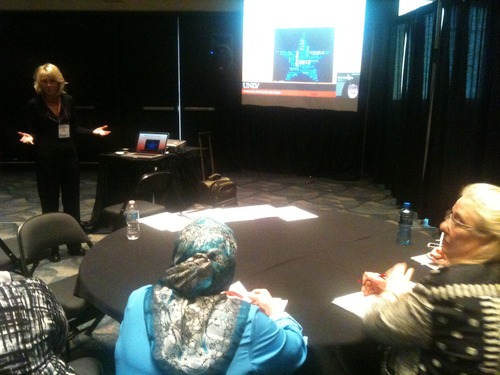Learning2gether Episode 149
March 21-23, Learning2gether traveled to Dallas to help webcast live at from the Electronic Village and academic sessions taking place during the TESOL Convention
Above, Vicki Holmes presenting on Word Clouds in the CALL-IS EV in Dallas, with co-presenter Ellen Dougherty Skyping in via small window lower right of screen, later expanded to full screen share so she could direct the workshop from Abu Dhabi – picture, Vance Stevens
Many of these events were held in the Webheads Bb Collaborate / Elluminate room:
http://learningtimesevents.org/webheads/
For definitive updates to these events, please see the official sites:
- At the CALL-IS TESOL Webinar wiki site: http://callis2013.pbworks.com/
Thu March 21 – CALL Academic Session: Gaming and Language Learning
Recordings:
- Bb Collaborate / Elluminate – https://sas.elluminate.com/p.jnlp?psid=2013-03-21.0738.M.7AE801FFB697DA460D4B…
- mp3 – http://dl.dropbox.com/u/40757132/bootlegMP3/callisgaming-LEARNINGTIMES-V.10-0…
Thu March 21 – TESOL CALL-IS Open Meeting
Recordings:
- Bb Collaborate / Elluminate – https://sas.elluminate.com/p.jnlp?psid=2013-03-21.1417.M.7AE801FFB697DA460D4B…
Fri March 22 – Technology Showcase Event: Mobile Apps for Education
Recordings:
- mp3 – http://dl.dropbox.com/u/40757132/bootlegMP3/mobileapps-LEARNINGTIMES-64K.mp3
- Bb Collaborate / Elluminate – https://sas.elluminate.com/p.jnlp?psid=2013-03-22.0758.M.7AE801FFB697DA460D4B…
Fri March 22 – CALL-IS & Elementary Education InterSection Session: New Tools/Techniques in CALL
Recordings:
- Bb Collaborate / Elluminate – https://sas.elluminate.com/p.jnlp?psid=2013-03-22.1054.M.7AE801FFB697DA460D4B…
- mp3 – http://dl.dropbox.com/u/40757132/bootlegMP3/toolstechniques-LEARNINGTIMES-V.1…
- Vance’s slides “Training Teachers in Web2.0 Tools for Teaching and Learning EFL”
http://www.slideshare.net/vances/training-teachers-in-web2
Sat March 23 – ITA, CALL, & VDM-IS InterSection Session: New Technology Horizons for International Teaching Assistants
Recordings:
- Bb Collaborate / Elluminate – https://sas.elluminate.com/p.jnlp?psid=2013-03-23.0720.M.7AE801FFB697DA460D4B…
- mp3 – http://dl.dropbox.com/u/40757132/bootlegMP3/ITAcallSPL-LEARNINGTIMES-V.10-001…
Sat March 23 – ESP, CALL, & VDM-IS: Harmony in ESP Practice with Computers, Video and Digital Media
Recordings:
- Bb Collaborate / Elluminate – https://sas.elluminate.com/p.jnlp?psid=2013-03-23.1313.M.7AE801FFB697DA460D4B…
- mp3 – http://dl.dropbox.com/u/40757132/bootlegMP3/Harmony-LEARNINGTIMES-V.10-001.64…
Fri March 22 19:00 to 19:50 GMT – Webcasts from the EV Fair Classics
Evelyn Izquierdo, and Miguel Mendoza at EV Fair Friday (picture by Elizabeth Hanson-Smith)
- Shaping the Way We Teach English Leslie Opp-Beckman (U of Oregon)
- Session recording: http://tinyurl.com/tesol-webcast1-rec
- Moodle for Teachers Nellie Deutsch, Atlantic U
- Oh, What a Site! Google Sites for Language Learning Sandy Wagner (Defense Language Institute at Monterey)
- Session recording: http://tinyurl.com/tesol-webcast2-rec
- Podcasts, web-based recordings, & videocasts: Dynamic and interactive ways to provide feedback Evelyn Izquierdo and Miguel Mendoza (Universidad Centrale de Venezuela)
- Session recording: http://tinyurl.com/tesol-webcast3-rec
- EVO Mentoring Daniela C. Wagner-Loera (Maryland English Institute, Maryland USA)
- Session recording: http://tinyurl.com/tesol-webcast4-rec
Sat March 23 16:00 to 16:50 GMT – Webcasts from the EV Fair Classics
- Women Teaching Women English (WTWE) Leslie Opp-Beckman (U of Oregon),Rawan Yaghi (Bednayel Public School, Lebanon), Deanna Hochstein (U of Oregon), Deborah Healey (U of Oregon)
- EVO: Multiliteracies MOOC – Vance Stevens (Al Ain Men’s College UAE), Claire Bradin Siskin (Universidade Agostinho Neto)
- Elluminate recording: http://tinyurl.com/tesol-webcast6-rec
- Download the mp3: https://learning2getherdotnet.files.wordpress.com/2013/03/6-tesol-webcast-6-64k.mp3
Vance Stevens presenting MultiMOOC at EV Fair Saturday (picture by Elizabeth Hanson-Smith)
- Student Projects and More Using Nicenet.org – Jim Bame, Utah State U
- Session recording: http://tinyurl.com/tesol-webcast7-rec







